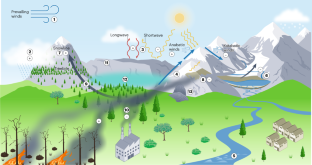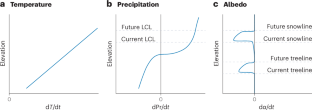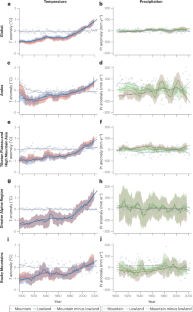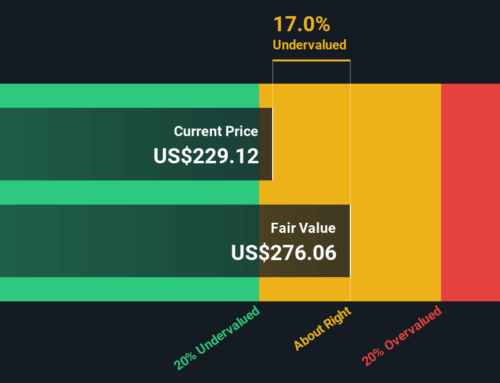Elevation-dependent climate change in mountain environments
November 25, 2025
Abstract
Mountain regions show rapid environmental changes under anthropogenic warming. The rates of these changes are often stratified by elevation, leading to elevation-dependent climate change (EDCC). In this Review, we examine evidence of systematic change in the elevation profiles of air temperature and precipitation (including snow). On a global scale, differences between mountain and lowland trends for temperature, precipitation and snowfall are 0.21 °C century–1 (enhanced mountain warming), –11.5 mm century–1 (enhanced mountain drying) and –25.6 mm century–1 (enhanced mountain snow loss), respectively, for 1980–2020, based on averaging available gridded datasets. Regional analyses sometimes show opposite trend patterns. This EDCC is primarily driven by changes in surface albedo, specific humidity and atmospheric aerosol concentrations. Throughout the twenty-first century, most models predict that enhanced warming in mountain regions will continue (at 0.13 °C century–1), but precipitation changes are less certain. Superimposed upon these global trends, EDCC patterns can vary substantially between mountain regions. Patterns in the Rockies and the Tibetan Plateau are more consistent with the global mean than other regions. In situ mountain observations are skewed towards low elevations, and understanding of EDCC is biased towards mid-latitudes. Efforts to address this uneven data distribution and to increase the spatial and temporal resolution of models of mountain processes are urgently needed to understand the impacts of EDCC on ecological and hydrological systems.
This is a preview of subscription content, access via your institution
Access options
Access Nature and 54 other Nature Portfolio journals
Get Nature+, our best-value online-access subscription
$32.99 /Â 30Â days
cancel any time
Subscribe to this journal
Receive 12 digital issues and online access to articles
$119.00 per year
only $9.92 per issue
Buy this article
- Purchase on SpringerLink
- Instant access to full article PDF
Prices may be subject to local taxes which are calculated during checkout





References
-
IPCC. Summary for Policymakers. In Climate Change 2021: The Physical Science Basis (eds. Masson-Delmotte, V. et al.) 3–32 (Cambridge Univ. Press, 2021).
-
Rantanen, M. et al. The Arctic has warmed nearly four times faster than the globe since 1979. Commun. Earth Environ. 3, 168 (2022).
-
Letterly, A., Key, J. & Liu, Y. Arctic climate: changes in sea ice extent outweigh changes in snow cover. Cryosphere 12, 3373–3382 (2018).
-
Jenkins, M. & Dai, A. The impact of sea-ice loss on Arctic climate feedbacks and their role for Arctic amplification. Geophys. Res. Lett. 48, e2021GL094599 (2021).
-
Mudryk, L. et al. Historical Northern Hemisphere snow cover trends and projected changes in the CMIP6 multi-model ensemble. Cryosphere 14, 2495–2514 (2020).
-
Oehri, J. et al. Vegetation type is an important predictor of the Arctic summer land surface energy budget. Nat. Commun. 13, 6379 (2022).
-
Previdi, M., Smith, K. L. & Polvani, L. M. Arctic amplification of climate change: a review of underlying mechanisms. Environ. Res. Lett. 16, 093003 (2021).
-
Wang, Q., Fan, X. & Wang, M. Evidence of high-elevation amplification versus Arctic amplification. Sci. Rep. 6, 19219 (2016).
-
You, Q. et al. Warming amplification over the Arctic Pole and Third Pole: trends, mechanisms and consequences. Earth Sci. Rev. 217, 103625 (2021).
-
Pepin, N. et al. Elevation-dependent warming in mountain regions of the world. Nat. Clim. Change 5, 424–430 (2015).
-
Pepin, N. C. & Lundquist, J. D. Temperature trends at high elevations: patterns across the globe. Geophys. Res. Lett. https://doi.org/10.1029/2008GL034026 (2008).
-
Rottler, E., Kormann, C., Francke, T. & Bronstert, A. Elevation-dependent warming in the Swiss Alps 1981–2017: features, forcings and feedbacks. Int. J. Climatol. 39, 2556–2568 (2019).
-
Loomis, S. E. et al. The tropical lapse rate steepened during the last glacial maximum. Sci. Adv. 3, e1600815 (2017).
-
Pepin, N. C. et al. Climate changes and their elevational patterns in the mountains of the world. Rev. Geophys. https://doi.org/10.1029/2020RG000730 (2022).
-
Hock, R. & Rasul, G. in IPCC Special Report on the Ocean and Cryosphere in a Changing Climate (eds Portner, H.-O. & Roberts, D. C.) 131–202 (IPCC, Cambridge Univ. Press, 2019).
-
Kuhn, M. & Olefs, M. in Oxford Research Encyclopedia of Climate Science https://doi.org/10.1093/acrefore/9780190228620.013.762 (Oxford Univ. Press, 2020).
-
Giorgi, F. et al. Enhanced summer convective rainfall at Alpine high elevations in response to climate warming. Nat. Geosci. 9, 584–589 (2016).
-
Napoli, A., Crespi, A., Ragone, F., Maugeri, M. & Pasquero, C. Variability of orographic enhancement of precipitation in the Alpine region. Sci. Rep. 9, 13352 (2019).
-
Notarnicola, C. Overall negative trends for snow cover extent and duration in global mountain regions over 1982–2020. Sci. Rep. 12, 13731 (2022).
-
Notarnicola, C. Hotspots of snow cover changes in global mountain regions over 2000–2018. Remote Sens. Environ. 243, 111781 (2020).
-
Zhu, L. et al. Elevation-dependent sensible heat flux trend over the Tibetan Plateau and its possible causes. Clim. Dyn. 52, 3997–4009 (2019).
-
Guo, X., Wang, L., Tian, L. & Li, X. Elevation-dependent reductions in wind speed over and around the Tibetan Plateau. Int. J. Climatol. 37, 1117–1126 (2017).
-
Rasul, G. & Molden, D. The global social and economic consequences of mountain cryospheric change. Front. Environ. Sci. https://doi.org/10.3389/fenvs.2019.00091 (2019).
-
Immerzeel, W. W. et al. Importance and vulnerability of the world’s water towers. Nature 577, 364–369 (2020).
-
Musselman, K. N., Addor, N., Vano, J. A. & Molotch, N. P. Winter melt trends portend widespread declines in snow water resources. Nat. Clim. Change 11, 418–424 (2021).
-
Marty, C. & Tilg, A. M. Recent evidence of large-scale receding snow water equivalents in the European Alps. J. Hydrometeorol. 18, 1021–1031 (2017).
-
Vuille, M. et al. Rapid decline of snow and ice in the tropical Andes — impacts, uncertainties and challenges ahead. Earth Sci. Rev. 176, 195–213 (2018).
-
Matiu, M. et al. Observed snow depth trends in the European Alps: 1971 to 2019. Cryosphere 15, 1343–1382 (2021).
-
Hugonnet, R. et al. Accelerated global glacier mass loss in the early twenty-first century. Nature 592, 726–731 (2021).
-
Guidicelli, M., Huss, M., Gabella, M. & Salzmann, N. Spatio-temporal reconstruction of winter glacier mass balance in the Alps, Scandinavia, Central Asia and western Canada (1981–2019) using climate reanalyses and machine learning. Cryosphere 17, 977–1002 (2023).
-
Milner, A. M. et al. Glacier shrinkage driving global changes in downstream systems. PNAS 114, 9770–9778 (2017).
-
Fuchs, S. et al. Short communication: a model to predict flood loss in mountain areas. Environ. Model. Softw. 117, 176–180 (2019).
-
Feng, W., Lu, H., Yao, T. & Yu, Q. Drought characteristics and its elevation dependence in the Qinghai–Tibet plateau during the last half-century. Sci. Rep. 10, 14323 (2020).
-
Gariano, S. L. & Guzzetti, F. Landslides in a changing climate. Earth Sci. Rev. 162, 227–252 (2016).
-
Haeberli, W., Schaub, Y. & Huggel, C. Increasing risks related to landslides from degrading permafrost into new lakes in de-glaciating mountain ranges. Geomorphology 293, 405–417 (2017).
-
Giacona, F. et al. Upslope migration of snow avalanches in a warming climate. PNAS 118, e2107306118 (2021).
-
Ding, Y. et al. Increasing cryospheric hazards in a warming climate. Earth Sci. Rev. 213, 103500 (2021).
-
Harrison, S. et al. Climate change and the global pattern of moraine-dammed glacial lake outburst floods. Cryosphere 12, 1195–1209 (2018).
-
Veh, G. et al. Progressively smaller glacier lake outburst floods despite worldwide growth in lake area. Nat. Water 3, 271–283 (2025).
-
Li, Z. et al. Altitude dependency of trends of daily climate extremes in southwestern China, 1961–2008. J. Geogr. Sci. 22, 416–430 (2012).
-
You, Q. et al. Changes in daily climate extremes in China and their connection to the large scale atmospheric circulation during 1961–2003. Clim. Dyn. 36, 2399–2417 (2011).
-
Salzmann, N., Scherrer. S., Allen, S. & Roher, M. in The High Mountain Cryosphere (eds Huggel, C. et al.) 28–49 (Cambridge Univ. Press, 2015).
-
Bondesan, A. & Francese, R. G. The climate-driven disaster of the Marmolada Glacier (Italy). Geomorphology 431, 108687 (2023).
-
Bozzoli, M. et al. Long-term snowfall trends and variability in the Alps. Int. J. Climatol. 44, 4571–4591, https://doi.org/10.1002/joc.8597 (2024).
-
Alizadeh, M. R. et al. Warming enabled upslope advance in western US forest fires. Proc. Natl Acad. Sci. USA 118, e2009717118 (2021).
-
Davolio, S., Della Fera, S., Laviola, S., Miglietta, M. M. & Levizzani, V. Heavy precipitation over Italy from the Mediterranean storm ‘Vaia’ in October 2018: assessing the role of an atmospheric river. Mon. Weather. Rev. 148, 3571–3588 (2020).
-
Giovannini, L., Davolio, S., Zaramella, M., Zardi, D. & Borga, M. Multi-model convection-resolving simulations of the October 2018 Vaia storm over Northeastern Italy. Atmos. Res. 253, 105455 (2021).
-
Anderegg, W. R. L. et al. Tree mortality from drought, insects, and their interactions in a changing climate. N. Phytol. 208, 674–683 (2015).
-
Ghatak, D., Sinsky, E. & Miller, J. Role of snow-albedo feedback in higher elevation warming over the Himalayas, Tibetan Plateau and Central Asia. Environ. Res. Lett. 9, 114008 (2014).
-
Palazzi, E., Filippi, L. & von Hardenberg, J. Insights into elevation-dependent warming in the Tibetan Plateau-Himalayas from CMIP5 model simulations. Clim. Dyn. 48, 3991–4008 (2017).
-
Palazzi, E., Mortarini, L., Terzago, S. & von Hardenberg, J. Elevation-dependent warming in global climate model simulations at high spatial resolution. Clim. Dyn. 52, 2685–2702 (2019).
-
Rangwala, I., Sinsky, E. & Miller, J. R. Variability in projected elevation dependent warming in boreal midlatitude winter in CMIP5 climate models and its potential drivers. Clim. Dyn. 46, 2115–2122 (2016).
-
Lugauer, M. et al. Aerosol transport to the high Alpine sites Jungfraujoch (3454 m asl) and Colle Gnifetti (4452 m asl). Tellus B Chem. Phys. Meteorol. 50, 76–92 (1998).
-
Napoli, A., Desbiolles, F., Parodi, A. & Pasquero, C. Aerosol indirect effects in complex-orography areas: a numerical study over the Great Alpine Region. Atmos. Chem. Phys. 22, 3901–3909 (2022).
-
Jerez, S. et al. Sensitivity of surface solar radiation to aerosol-radiation and aerosol-cloud interactions over Europe in WRFv3.6.1 climatic runs with fully interactive aerosols. Geosci. Model. Dev. 14, 1533–1551 (2021).
-
Barry, R. Mountain Weather and Climate (Cambridge Univ. Press, 2008).
-
Held, I. M. & Soden, B. J. Robust responses of the hydrological cycle to global warming. J. Clim. 19, 5686–5699 (2006).
-
Vergara-Temprado, J., Ban, N. & Schär, C. Extreme sub-hourly precipitation intensities scale close to the clausius-clapeyron rate over Europe. Geophys. Res. Lett. https://doi.org/10.1029/2020GL089506 (2021).
-
Houze, R. A., Rasmussen, K. L., Zuluaga, M. D. & Brodzik, S. R. The variable nature of convection in the tropics and subtropics: a legacy of 16 years of the Tropical Rainfall Measuring Mission satellite. Rev. Geophys. 53, 994–1021 (2015).
-
Kad, P., Ha, K. J., Lee, S. S. & Chu, J. E. Projected changes in mountain precipitation under CO2-induced warmer climate. Earths Future https://doi.org/10.1029/2023EF003886 (2023).
-
Siler, N. & Roe, G. How will orographic precipitation respond to surface warming? An idealized thermodynamic perspective. Geophys. Res. Lett. 41, 2606–2613 (2014).
-
Robinson, D. A. & Kukla, G. Albedo of a dissipating snow cover. J. Clim. Appl. Meteorol. 23, 1626–1634 (1984).
-
Skiles, S. M., Flanner, M., Cook, J. M., Dumont, M. & Painter, T. H. Radiative forcing by light-absorbing particles in snow. Nat. Clim. Change 8, 964–971 (2018).
-
Hadley, O. L. & Kirchstetter, T. W. Black-carbon reduction of snow albedo. Nat. Clim. Change 2, 437–440 (2012).
-
Bonan, G. B. Forests and climate change: forcings, feedbacks, and the climate benefits of forests. Science 320, 1444–1449 (2008).
-
Wang, Y. et al. Increased stem density and competition may diminish the positive effects of warming at alpine treeline. Ecology 97, 1668–1679 (2016).
-
Ramtvedt, E. N., Bollandsås, O. M., Næsset, E. & Gobakken, T. Relationships between single-tree mountain birch summertime albedo and vegetation properties. Agric. For. Meteorol. 307, 108470 (2021).
-
Williamson, S. N., Barrio, I. C., Hik, D. S. & Gamon, J. A. Phenology and species determine growing-season albedo increase at the altitudinal limit of shrub growth in the sub-Arctic. Glob. Change Biol. 22, 3621–3631 (2016).
-
Harris, I., Osborn, T. J., Jones, P. & Lister, D. Version 4 of the CRU TS monthly high-resolution gridded multivariate climate dataset. Sci. Data 7, 109 (2020).
-
Lenssen, N. J. L. et al. Improvements in the GISTEMP Uncertainty Model. J. Geophys. Res. 124, 6307–6326 (2019).
-
Rohde, R. A. & Hausfather, Z. The Berkeley Earth Land/Ocean temperature record. Earth Syst. Sci. Data 12, 3469–3479 (2020).
-
Schneider, U. et al. Evaluating the hydrological cycle over land using the newly-corrected precipitation climatology from the Global Precipitation Climatology Centre (GPCC). Atmosphere 8, 52 (2017).
-
Hersbach, H. et al. The ERA5 global reanalysis. Q. J. R. Meteorol. Soc. 146, 1999–2049 (2020).
-
Taylor, K. E., Stouffer, R. J. & Meehl, G. A. An overview of CMIP5 and the experiment design. Bull. Am. Meteorol. Soc. 93, 485–498 (2012).
-
Fan, X., Wang, Q., Wang, M. & Jiménez, C. V. Warming amplification of minimum and maximum temperatures over high-elevation regions across the globe. PLoS ONE 10, e0140213 (2015).
-
Vuille, M., Franquist, E., Garreaud, R., Lavado Casimiro, W. S. & Cáceres, B. Impact of the global warming hiatus on Andean temperature. J. Geophys. Res. 120, 3745–3757 (2015).
-
Vuille, M., Bradley, R. S., Werner, M. & Keimig, F. 20th century climate change in the tropical Andes: observations and model results. Clim. Change 59, 75–99 (2003).
-
Aguilar-Lome, J. et al. Elevation-dependent warming of land surface temperatures in the Andes assessed using MODIS LST time series (2000–2017). Int. J. Appl. Earth Obs. Geoinf. 77, 119–128 (2019).
-
Ferguglia, O., Palazzi, E. & Arnone, E. Elevation dependent change in ERA5 precipitation and its extremes. Clim. Dyn. 62, 8137–8153 (2024).
-
Saavedra, F. A., Kampf, S. K., Fassnacht, S. R. & Sibold, J. S. Changes in Andes snow cover from MODIS data, 2000-2016. Cryosphere 12, 1027–1046 (2018).
-
You, Q. et al. Elevation dependent warming over the Tibetan Plateau: Patterns, mechanisms and perspectives. Earth Sci. Rev. 210, 103349 (2020).
-
Gao, Y. et al. Does elevation-dependent warming hold true above 5000 m elevation? Lessons from the Tibetan Plateau. NPJ Clim. Atmos. Sci. 1, 19 (2018).
-
Pepin, N. et al. An examination of temperature trends at high elevations across the Tibetan Plateau: the use of MODIS LST to understand patterns of elevation-dependent warming. J. Geophys. Res. 124, 5738–5756 (2019).
-
Guo, D., Sun, J., Yang, K., Pepin, N. & Xu, Y. Revisiting recent elevation-dependent warming on the Tibetan Plateau using satellite-based data sets. J. Geophys. Res. 124, 8511–8521 (2019).
-
Li, B., Chen, Y. & Shi, X. Does elevation dependent warming exist in high mountain Asia? Environ. Res. Lett. 15, 024012 (2020).
-
Rangwala, I., Sinsky, E. & Miller, J. R. Amplified warming projections for high altitude regions of the northern hemisphere mid-latitudes from CMIP5 models. Environ. Res. Lett. 8, 024040 (2013).
-
Guo, D., Pepin, N., Yang, K., Sun, J. & Li, D. Local changes in snow depth dominate the evolving pattern of elevation-dependent warming on the Tibetan Plateau. Sci. Bull. 66, 1146–1150 (2021).
-
Gao, L. et al. Evidence of elevation-dependent warming from the Chinese Tian Shan. Cryosphere 15, 5765–5783 (2021).
-
Thakuri, S. et al. Elevation-dependent warming of maximum air temperature in Nepal during 1976–2015. Atmos. Res. 228, 261–269 (2019).
-
Dimri, A. P., Palazzi, E. & Daloz, A. S. Elevation dependent precipitation and temperature changes over Indian Himalayan region. Clim. Dyn. 59, 1–21 (2022).
-
International Centre for Integrated Mountain Development (ICIMOD). Water, Ice, Society, and Ecosystems in the Hindu Kush Himalaya: An Outlook (ICIMOD, 2023).
-
Collier, E. & Immerzeel, W. W. High-resolution modeling of atmospheric dynamics in the Nepalese Himalaya. J. Geophys. Res. 120, 9882–9896 (2015).
-
Yang, K. et al. Impact of summer monsoon on the elevation-dependence of meteorological variables in the south of central Himalaya. Int. J. Climatol. 38, 1748–1759 (2018).
-
Li, Y. et al. Contribution of Tibetan Plateau ecosystems to local and remote precipitation through moisture recycling. Glob. Change Biol. 29, 702–718 (2023).
-
Guo, L. & Li, L. Variation of the proportion of precipitation occurring as snow in the Tian Shan Mountains, China. Int. J. Climatol. 35, 1379–1393 (2015).
-
Li, Z., Chen, Y., Li, Y. & Wang, Y. Declining snowfall fraction in the alpine regions, Central Asia. Sci. Rep. 10, 3476 (2020).
-
Zhang, X. et al. Observed changes in extreme precipitation over the Tienshan Mountains and associated large-scale climate teleconnections. J. Hydrol. 606, 127457 (2022).
-
Kang, S., Zhang, Y., Qian, Y. & Wang, H. A review of black carbon in snow and ice and its impact on the cryosphere. Earth Sci. Rev. 210, 103346 (2020).
-
Xu, Y., Ramanathan, V. & Washington, W. M. Observed high-altitude warming and snow cover retreat over Tibet and the Himalayas enhanced by black carbon aerosols. Atmos. Chem. Phys. 16, 1303–1315 (2016).
-
Xiao, Y., Ke, C. Q., Shen, X., Cai, Y. & Li, H. What drives the decrease of glacier surface albedo in High Mountain Asia in the past two decades? Sci. Total Environ. 863, 160945 (2023).
-
Tang, Z. et al. Spatiotemporal variation of snowline altitude at the end of melting season across High Mountain Asia, using MODIS snow cover product. Adv. Space Res. 66, 2629–2645 (2020).
-
Guo, Z. et al. Spatiotemporal variability in the glacier snowline altitude across High Mountain Asia and potential driving factors. Remote Sens. 13, 425 (2021).
-
Wang, J. et al. Landsat Satellites observed dynamics of snowline altitude at the end of the melting season, Himalayas, 1991–2022. Remote Sens. 15, 2534 (2023).
-
Mishra, N. B. & Mainali, K. P. Greening and browning of the Himalaya: Spatial patterns and the role of climatic change and human drivers. Sci. Total Environ. 587–588, 326–339 (2017).
-
Bigi, A., Ghermandi, G. & Harrison, R. M. Analysis of the air pollution climate at a background site in the Po valley. J. Environ. Monit. 14, 552–563 (2012).
-
Guariso, G. & Volta, M. Air Quality Integrated Assessment: A European Perspective http://www.polimi.it (Springer, 2017).
-
Auer, I. et al. HISTALP — historical instrumental climatological surface time series of the Greater Alpine Region. Int. J. Climatol. 27, 17–46 (2007).
-
Ceppi, P., Scherrer, S. C., Fischer, A. M. & Appenzeller, C. Revisiting Swiss temperature trends 1959–2008. Int. J. Climatol. 32, 203–213 (2012).
-
Gobiet, A. et al. Sci. Total Environ. 493, 1138–1151 (2014).
-
Tudoroiu, M. et al. Negative elevation-dependent warming trend in the Eastern Alps. Environ. Res. Lett. 11, 044021 (2016).
-
Zeng, Z. et al. Regional air pollution brightening reverses the greenhouse gases induced warming-elevation relationship. Geophys. Res. Lett. 42, 4563–4572 (2015).
-
Manara, V., Bassi, M., Brunetti, M., Cagnazzi, B. & Maugeri, M. 1990–2016 surface solar radiation variability and trend over the Piedmont region (northwest Italy). Theor. Appl. Climatol. 136, 849–862 (2019).
-
Gevorgyan, A., Melkonyan, H., Aleksanyan, T., Iritsyan, A. & Khalatyan, Y. An assessment of observed and projected temperature changes in Armenia. Arab. J. Geosci. 9, 27 (2016).
-
Tashilova, A. A., Kesheva, L. A., Teunova, N. V. & Taubekova, Z. A. Analysis of temperature variability in the mountain regions of the North Caucasus in 1961–2013. Russ. Meteorol. Hydrol. 41, 601–609 (2016).
-
Ashabokov, B. A., Beytuganov, M. N., Tashilova, A. A., Fedchenko, L. M. & Shapovalov, A. V. Changes of temperature and precipitation regimes in the south of European Russia in 1961-2015. MAUSAM 69, 553–562 (2018).
-
Dallan, E., Borga, M., Zaramella, M. & Marra, F. Enhanced summer convection explains observed trends in extreme subdaily precipitation in the Eastern Italian Alps. Geophys. Res. Lett. https://doi.org/10.1029/2021GL096727 (2022).
-
Bertoldi, G. et al. Diverging snowfall trends across months and elevation in the northeastern Italian Alps. Int. J. Climatol. 43, 2794–2819 (2023).
-
Serquet, G., Marty, C., Dulex, J. P. & Rebetez, M. Seasonal trends and temperature dependence of the snowfall/precipitation-day ratio in Switzerland. Geophys. Res. Lett. https://doi.org/10.1029/2011GL046976 (2011).
-
Diaz, H. F. & Eischeid, J. K. Disappearing ‘alpine tundra’ Köppen climatic type in the western United States. Geophys. Res. Lett. https://doi.org/10.1029/2007GL031253 (2007).
-
Oyler, J. W., Dobrowski, S. Z., Ballantyne, A. P., Klene, A. E. & Running, S. W. Artificial amplification of warming trends across the mountains of the western United States. Geophys. Res. Lett. 42, 153–161 (2015).
-
McAfee, S. A., McCabe, G. J., Gray, S. T. & Pederson, G. T. Changing station coverage impacts temperature trends in the Upper Colorado River basin. Int. J. Climatol. 39, 1517–1538 (2019).
-
Williamson, S. N. et al. Evidence for elevation-dependent warming in the St. Elias Mountains, Yukon, Canada. J. Clim. 33, 3253–3269 (2020).
-
Luce, C. H., Abatzoglou, J. T. & Holden, Z. A. The missing mountain water: slower westerlies decrease orographic enhancement in the Pacific Northwest USA. Science 342, 1360–1364 (2013).
-
Mote, P. W., Li, S., Lettenmaier, D. P., Xiao, M. & Engel, R. Dramatic declines in snowpack in the western US. npj Clim. Atmos. Sci. 1, 2 (2018).
-
Engstrom, C. B., Williamson, S. N., Gamon, J. A. & Quarmby, L. M. Seasonal development and radiative forcing of red snow algal blooms on two glaciers in British Columbia, Canada, summer 2020. Remote Sens. Environ. 280, 113164 (2022).
-
Gabbi, J., Huss, M., Bauder, A., Cao, F. & Schwikowski, M. The impact of Saharan dust and black carbon on albedo and long-term mass balance of an Alpine glacier. Cryosphere 9, 1385–1400 (2015).
-
Gleason, K. E., McConnell, J. R., Arienzo, M. M., Sexstone, G. A. & Rahimi, S. Black carbon dominated dust in recent radiative forcing on Rocky Mountain snowpacks. Environ. Res. Lett. 17, 054045 (2022).
-
Deems, J. S., Painter, T. H., Barsugli, J. J., Belnap, J. & Udall, B. Combined impacts of current and future dust deposition and regional warming on Colorado River Basin snow dynamics and hydrology. Hydrol. Earth Syst. Sci. 17, 4401–4413 (2013).
-
Niu, X., Tang, J., Chen, D., Wang, S. & Ou, T. Elevation-dependent warming over the Tibetan Plateau from an ensemble of CORDEX-EA regional climate simulations. J. Geophys. Res. 126, e2020JD033997 (2021).
-
Yan, L., Liu, Z., Chen, G., Kutzbach, J. E. & Liu, X. Mechanisms of elevation-dependent warming over the Tibetan Plateau in quadrupled CO2 experiments. Clim. Change 135, 509–519 (2016).
-
Minder, J. R., Letcher, T. W. & Liu, C. The character and causes of elevation-dependent warming in high-resolution simulations of Rocky Mountain climate change. J. Clim. 31, 2093–2113 (2018).
-
Kotlarski, S. et al. 21st century alpine climate change. Clim. Dyn. 60, 65–86 (2023).
-
Urrutia, R. & Vuille, M. Climate change projections for the tropical Andes using a regional climate model: temperature and precipitation simulations for the end of the 21st century. J. Geophys. Res. Atmos. https://doi.org/10.1029/2008JD011021 (2009).
-
Toledo, O., Palazzi, E., Cely Toro, I. M. & Mortarini, L. Comparison of elevation-dependent warming and its drivers in the tropical and subtropical Andes. Clim. Dyn. 58, 3057–3074 (2022).
-
Zazulie, N., Rusticucci, M. & Raga, G. B. Regional climate of the Subtropical Central Andes using high-resolution CMIP5 models. Part II: Future projections for the twenty-first century. Clim. Dyn. 51, 2913–2925 (2018).
-
Niu, X. et al. The performance of CORDEX-EA-II simulations in simulating seasonal temperature and elevation-dependent warming over the Tibetan Plateau. Clim. Dyn. 57, 1135–1153 (2021).
-
Dimri, A. P., Bookhagen, B., Stoffel, M. & Yasunari, T. Himalayan Weather and Climate and Their Impact on the Environment (Springer, 2019).
-
Kotlarski, S., Lüthi, D. & Schär, C. The elevation dependency of 21st century European climate change: an RCM ensemble perspective. Int. J. Climatol. 35, 3902–3920 (2015).
-
Napoli, A., Parodi, A., von Hardenberg, J. & Pasquero, C. Altitudinal dependence of projected changes in occurrence of extreme events in the Great Alpine Region. Int. J. Climatol. 43, 5813–5829 (2023).
-
Frei, P., Kotlarski, S., Liniger, M. A. & Schär, C. Future snowfall in the Alps: projections based on the EURO-CORDEX regional climate models. Cryosphere 12, 1–24 (2018).
-
Fang, H., Baiping, Z., Yonghui, Y., Yunhai, Z. & Yu, P. Mass elevation effect and its contribution to the altitude of snowline in the Tibetan Plateau and surrounding areas. Arct. Antarct. Alp. Res. 43, 207–212 (2011).
-
Pepin, N. C. & Seidel, D. J. A global comparison of surface and free-air temperatures at high elevations. J. Geophys. Res. D 110, 1–15 (2005).
-
Magalhães, N., Evangelista, H., Condom, T., Rabatel, A. & Ginot, P. Amazonian biomass burning enhances tropical Andean glaciers melting. Sci. Rep. 9, 16914 (2019).
-
Thornton, J. M., Pepin, N., Shahgedanova, M. & Adler, C. Coverage of in situ climatological observations in the world’s mountains. Front. Clim. https://doi.org/10.3389/fclim.2022.814181 (2022).
-
Nitu, R. et al. Instruments and Observing Methods WMO Solid Precipitation Intercomparison Experiment (SPICE) (2012-2015). https://library.wmo.int/viewer/56317/download?file=iom_131_en_1.pdf&type=pdf&navigator=1 (2018).
-
Rangwala, I. & Miller, J. R. Climate change in mountains: a review of elevation-dependent warming and its possible causes. Clim. Change 114, 527–547 (2012).
-
Pepin, N. et al. Proposal for the Unified High Elevation Observing Platform (UHOP) https://doi.org/10.48620/77051 (2024).
-
Mo, Y., Pepin, N. & Lovell, H. Understanding temperature variations in mountainous regions: the relationship between satellite-derived land surface temperature and in situ near-surface air temperature. Remote Sens. Environ. 318, 114574 (2025).
-
Williamson, S. N., Copland, L. & Hik, D. S. The accuracy of satellite-derived albedo for northern alpine and glaciated land covers. Polar Sci. 10, 262–269 (2016).
-
Guidicelli, M., Aalstad, K., Treichler, D. & Salzmann, N. A combined data assimilation and deep learning approach for continuous spatio-temporal SWE reconstruction from sparse ground tracks. J. Hydrol. X 25, 100190 (2024).
-
Helmer, E. H. et al. Neotropical cloud forests and páramo to contract and dry from declines in cloud immersion and frost. PLoS ONE 14, e0213155 (2019).
-
Veettil, B. K. & Kamp, U. Global disappearance of tropical mountain glaciers: observations, causes, and challenges. Geosciences 9, 196 (2019).
-
Xian, T. et al. Is Hadley cell expanding? Atmosphere 12, 1699 (2021).
-
Keil, P., Schmidt, H., Stevens, B. & Bao, J. Variations of tropical lapse rates in climate models and their implications for upper-tropospheric warming. J. Clim. 34, 1–50 (2021).
-
Bao, J., Stevens, B., Kluft, L. & Jiménez-de-la-Cuesta, D. Changes in the tropical lapse rate due to entrainment and their impact on climate sensitivity. Geophys. Res. Lett. 48, e2021GL094969 (2021).
-
Schauwecker, S. et al. The freezing level in the tropical Andes, Peru: an indicator for present and future glacier extents. J. Geophys. Res. 122, 5172–5189 (2017).
-
Los, S. O. et al. Sensitivity of a tropical montane cloud forest to climate change, present, past and future: Mt. Marsabit, N. Kenya. Quat. Sci. Rev. 218, 34–48 (2019).
-
Ferguson, B. N. et al. Variation in cloud immersion, not precipitation, drives leaf trait plasticity and water relations in vascular epiphytes during an extreme drought. Am. J. Bot. 109, 550–563 (2022).
-
Kageyama, M., Harrison, S. P. & Abe-Ouchi, A. The depression of tropical snowlines at the last glacial maximum: what can we learn from climate model experiments? Quat. Int. 138–139, 202–219 (2005).
-
Palmer, P. I. et al. Drivers and impacts of Eastern African rainfall variability. Nat. Rev. Earth Environ. 4, 254–270 (2023).
-
Abermann, J. et al. Strong contrast in mass and energy balance between a coastal mountain glacier and the Greenland ice sheet. J. Glaciol. 65, 263–269 (2019).
-
Bromwich, D. H., Nicolas, J. P. & Monaghan, A. J. An assessment of precipitation changes over Antarctica and the Southern Ocean since 1989 in contemporary global reanalyses. J. Clim. 24, 4189–4209 (2011).
-
Xie, A. et al. Surface warming from altitudinal and latitudinal amplification over Antarctica since the International Geophysical Year. Sci. Rep. 13, 9536 (2023).
-
Palmer, M. D. et al. Exploring the drivers of global and local sea-level change over the 21st century and beyond. Earths Future 8, e2019EF001413 (2020).
-
Kattel, D. B. et al. Temperature lapse rate in complex mountain terrain on the southern slope of the central Himalayas. Theor. Appl. Climatol. 113, 671–682 (2013).
-
Pagès, M., Pepin, N. & Miró, J. R. Measurement and modelling of temperature cold pools in the Cerdanya valley (Pyrenees), Spain. Meteorol. Appl. 24, 290–302 (2017).
-
Hiebl, J. & Schöner, W. Temperature inversions in Austria in a warming climate — changes in space and time. Meteorol. Z. 27, 309–323 (2018).
-
Hartmann, D. L., Dygert, B. D., Blossey, P. N., Fu, Q. & Sokol, A. B. The vertical profile of radiative cooling and lapse rate in a warming climate. J. Clim. 35, 6253–6265 (2022).
-
Hermann, M., Wernli, H. & Röthlisberger, M. Drastic increase in the magnitude of very rare summer-mean vapor pressure deficit extremes. Nat. Commun. 15, 7022 (2024).
-
Collier, E. et al. The first ensemble of kilometer-scale simulations of a hydrological year over the third pole. Clim. Dyn. 62, 7501–7518 (2024).
-
Soares, P. M. M. et al. The added value of km-scale simulations to describe temperature over complex orography: the CORDEX FPS-Convection multi-model ensemble runs over the Alps. Clim. Dyn. 62, 4491–4514 (2024).
-
Thornton, J. M. et al. Toward a definition of essential mountain climate variables. One Earth 4, 805–827 (2021).
-
Liu, X., Cheng, Z., Yan, L. & Yin, Z. Y. Elevation dependency of recent and future minimum surface air temperature trends in the Tibetan Plateau and its surroundings. Glob. Planet. Change 68, 164–174 (2009).
-
Thornton, J. Inventory of in situ mountain observational infrastructure. GEO Mountains https://geomountains.org/resources-outputs/portals-inventories/ (2022).
-
Viviroli, D., Kummu, M., Meybeck, M., Kallio, M. & Wada, Y. Increasing dependence of lowland populations on mountain water resources. Nat. Sustain. 3, 917–928 (2020).
-
Dallan, E. et al. How well does a convection-permitting regional climate model represent the reverse orographic effect of extreme hourly precipitation? Hydrol. Earth Syst. Sci. 27, 1133–1149 (2023).
-
Formetta, G., Marra, F., Dallan, E., Zaramella, M. & Borga, M. Differential orographic impact on sub-hourly, hourly, and daily extreme precipitation. Adv. Water Resour. 159, 104085 (2022).
-
Sayre, R. et al. A new high-resolution map of world mountains and an online tool for visualizing and comparing characterizations of global mountain distributions. Mt. Res. Dev. 38, 240–249 (2018).
-
Luo, S., Yang, L. & Liu, J. Statistical characteristics analysis of global specific humidity vertical profile. In Proc. SPIE 2019 International Conference on Optical Instruments and Technology: Optoelectronic Measurement Technology and Systems Vol. 11439, https://doi.org/10.1117/12.2544132 (SPIE, 2020).
-
Zhang, H., Sun, M., Yao, X., Wang, Z. & Zhang, L. Spatial–temporal distribution of tropospheric specific humidity in the arid region of northwest China. Atmosphere 12, 349 (2021).
-
Körner, C. Alpine Plant Life: Functional Plant Ecology of High Mountain Ecosystems (Springer, 2021).
-
Letcher, T. W. & Minder, J. R. The simulated response of diurnal mountain winds to regionally enhanced warming caused by the snow albedo feedback. J. Atmos. Sci. 74, 49–67 (2017).
-
Wilson, J. W. Notes on wind and its effects in Arctic-Alpine vegetation. J. Ecol. 47, 415–427 (1959).
-
Acosta Navarro, J. C. et al. Future response of temperature and precipitation to reduced aerosol emissions as compared with increased greenhouse gas concentrations. J. Clim. 30, 939–954 (2017).
-
Lund, M. T., Myhre, G. & Samset, B. H. Anthropogenic aerosol forcing under the shared socioeconomic pathways. Atmos. Chem. Phys. 19, 13827–13839 (2019).
-
Merikanto, J. et al. How Asian aerosols impact regional surface temperatures across the globe. Atmos. Chem. Phys. 21, 5865–5881 (2021).
-
Baker, M. B. Cloud microphysics and climate. Science 276, 1072–1078 (1997).
-
Zelinka, M. D., Klein, S. A. & Hartmann, D. L. Computing and partitioning cloud feedbacks using cloud property histograms. Part II: Attribution to changes in cloud amount, altitude, and optical depth. J. Clim. 25, 3736–3754 (2012).
-
Wild, M. Enlightening global dimming and brightening. Bull. Am. Meteorol. Soc. 93, 27–37 (2012).
-
Pilinis, C., Seinfeld, J. H. & Grosjean, D. Water content of atmospheric aerosols. Atmos. Environ. 23, 1601–1606 (1989).
-
Musselman, K. N., Clark, M. P., Liu, C., Ikeda, K. & Rasmussen, R. Slower snowmelt in a warmer world. Nat. Clim. Change 7, 214–219 (2017).
-
Haeberli, W. & Weingartner, R. In full transition: key impacts of vanishing mountain ice on water-security at local to global scales. Water Secur. 11, 100074 (2020).
-
Li, L., Yang, S., Wang, Z., Zhu, X. & Tang, H. Evidence of warming and wetting climate over the Qinghai-Tibet plateau. Arct. Antarct. Alp. Res. 42, 449–457 (2010).
-
Deng, H. & Ji, Z. Warming and wetting will continue over the Tibetan Plateau in the Shared Socioeconomic Pathways. PLoS ONE 18, e0289589 (2023).
-
Moon, W., Kim, B.-M., Yang, G.-H. & Wettlaufer, J. S. Wavier jet streams driven by zonally asymmetric surface thermal forcing. Proc. Natl Acad. Sci. USA 119, e2200890119 (2022).
-
Francis, J. A. & Vavrus, S. J. Evidence for a wavier jet stream in response to rapid Arctic warming. Environ. Res. Lett. 10, 014005 (2015).
-
Woollings, T. et al. Blocking and its response to climate change. Curr. Clim. Change Rep. 4, 287–300 (2018).
-
Lundquist, J. D. & Cayan, D. R. Surface temperature patterns in complex terrain: daily variations and long-term change in the central Sierra Nevada, California. J. Geophys. Res. Atmos. https://doi.org/10.1029/2006JD007561 (2007).
-
Francis, J. A. Why are Arctic linkages to extreme weather still up in the air? Bull. Am. Meteorol. Soc. 98, 2551–2557 (2017).
-
Blackport, R. & Screen, J. A. Insignificant effect of Arctic amplification on the amplitude of midlatitude atmospheric waves. Sci. Adv. 6, eaay2880 (2020).
Acknowledgements
The authors acknowledge the Mountain Research Initiative for providing financial and logistical support for a workshop on Elevation Dependent Climate Change at the International Mountain Conference in Innsbruck in September 2022, at which the idea for this Review was conceived. E.P. was jointly funded by a Leverhulme Trust ECR fellowship, NERC grant NE/X004031/1 and the AgroClim-Huaraz project. A.N. was supported by Fondazione CARITRO (Cassa di Risparmio di Trento e Rovereto) within the project “Insight into the physical mechanisms underlying convection phenomena for a better understanding of its future evolution in the context of climate change in the Trentino region�. L.H. acknowledges the AgroClim Huarez project, funded by the Earth System Sciences Program of the Austrian Academy of Sciences (OEAW) and the European Union Horizon 2020 Marie Sklodowksa-Curie Action HIGHLANDS.3 project (grant no. 872328). D.Z. acknowledges support from the European Union — NextGenerationEU through the Italian National Recovery and Resilience Plan (PNRR), PRIN 2022 (grant no. 2022NEWP4J, CUP E53D23004450006); from the strategic partnerships ‘Space It Up!’, funded by the Italian Space Agency and the Ministry of University and Research (contract no. 2024-5-E.0-CUP  I53D24000060005); and from the iNEST initiative (Interconnected Nord-Est Innovation Ecosystem) funded by the European Union under NextGenerationEU (PNRR, Mission 4.2, Investment 1.5, project no. ECS 00000043).
Author information
Authors and Affiliations
Contributions
N.P. conceived the original idea, wrote large sections of the manuscript and coordinated the overall submission. M.A., J.K. and S.T. coordinated the writing of individual sections of the manuscript. S.N.W., L.H., A.N., S.T., E.P. and J.S. produced figures and/or tables. E.A. performed the analysis of trend dependence on elevation and produced corresponding figures and tables. All authors provided input to group discussions and/or comments on the manuscript draft.
Corresponding author
Ethics declarations
Competing interests
The authors declare no competing interests.
Peer review
Peer review information
Nature Reviews Earth & Environment thanks Giacomo Bertoldi, Bryan Mark and the other, anonymous, reviewer(s) for their contribution to the peer review of this work.
Additional information
Publisher’s note Springer Nature remains neutral with regard to jurisdictional claims in published maps and institutional affiliations.
Related links
EvK2CNR: https://www.evk2cnr.org/
GLORIA network: https://www.gloria.ac.at/network/general
Long-Term Ecological Research Network (LTER): https://lternet.edu/
Virtual Alpine Observatory: https://www.vao.bayern.de/
Supplementary information
Rights and permissions
Springer Nature or its licensor (e.g. a society or other partner) holds exclusive rights to this article under a publishing agreement with the author(s) or other rightsholder(s); author self-archiving of the accepted manuscript version of this article is solely governed by the terms of such publishing agreement and applicable law.
About this article
Cite this article
Pepin, N., Apple, M., Knowles, J. et al. Elevation-dependent climate change in mountain environments.
Nat Rev Earth Environ (2025). https://doi.org/10.1038/s43017-025-00740-4
-
Accepted: 14 October 2025
-
Published: 25 November 2025
-
Version of record: 25 November 2025
-
DOI: https://doi.org/10.1038/s43017-025-00740-4
Search
RECENT PRESS RELEASES
Related Post




